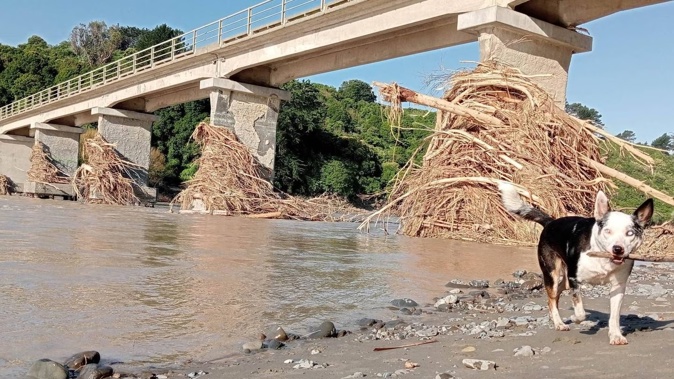
As Cyclone Gabrielle made its landing in Hawke’s Bay, Alice Jarvis-Basher and her partner felt vibrations in their orchard close to the Mohaka river mouth as debris slammed into the Mohaka Township Bridge.
As they stepped outside that morning, they found their driveway underwater and miles of wood debris along the beach.
They had no idea there was a national state of emergency until five days after the cyclone when Jarvis-Basher was able to get a single bar of reception standing on top of their truck at the top of a hill.
“We’re pretty much stuck on an island within New Zealand from the rivers.”
They can reach Wairoa, but the road to Gisborne remains risky with the recent rains worsening existing problems with slips.
Jarvis-Basher said more could have been done by authorities to get information about the state of emergency into the distant rural communities that had no access to power or cell coverage.
She said access to certain supplies remained very limited and when they did start arriving she was turned away when she asked for five litres of 91 petrol.
“Because I can’t get to town to work and neither can my partner, we are losing a lot of income and that sort of thing so I had to ring my mother last week and get a whole shipment of food for the animals flown to me personally.”
She said they were blessed to be on some raised ground so their avocado orchard was spared from any flooding but the wind was not so kind, knocking over several trees.
“We have lost a lot due to the cyclone, but not as much damage as across Hawke’s Bay.”
- Muriwai residents vent anger at Auckland Council staff over future of slip-hit houses
- Jehan Casinader and Kerry Prendergast face-off over Cyclone Gabrielle Lotto appeal
- 'Absolute devastation': White Island pilot shocked at Hawke's Bay
/cloudfront-ap-southeast-2.images.arcpublishing.com/nzme/QC5XEOJ4B5CNJIBLEJSJ4AMP6A.jpg) Slash and other wood debris along the beach near the Mohaka river mouth. Photo / Alice Grace Jarvis-Basher
Slash and other wood debris along the beach near the Mohaka river mouth. Photo / Alice Grace Jarvis-Basher
Jarvis-Basher estimates about 80 per cent of the debris along the beach near them is pine tree slash, with some uprooted natives.
“You can tell with the pine because the pine is cut and there are a lot of cut limbs and a lot of logs just lying around.”
She says the forestry slash “definitely” affected flooding in the area and the current ministerial inquiry was desperately needed to investigate this situation.
“The impact and the damage would have been less if the slash and silt weren’t a factor because all of that is quite heavy compared to water.”
Their property and the surrounding area fall just inside the Wairoa District, which is covered by the ministerial inquiry along with Tairawhiti.
According to the inquiry’s terms of reference, the inquiry must allow written submissions from anyone.
Wairoa Mayor Craig Little said all the bridges in their district had been inspected and a report had been compiled.
He said he understood that the Mohaka Township Bridge was one of those checked and determined safe enough to remain open to the public.
Take your Radio, Podcasts and Music with you









